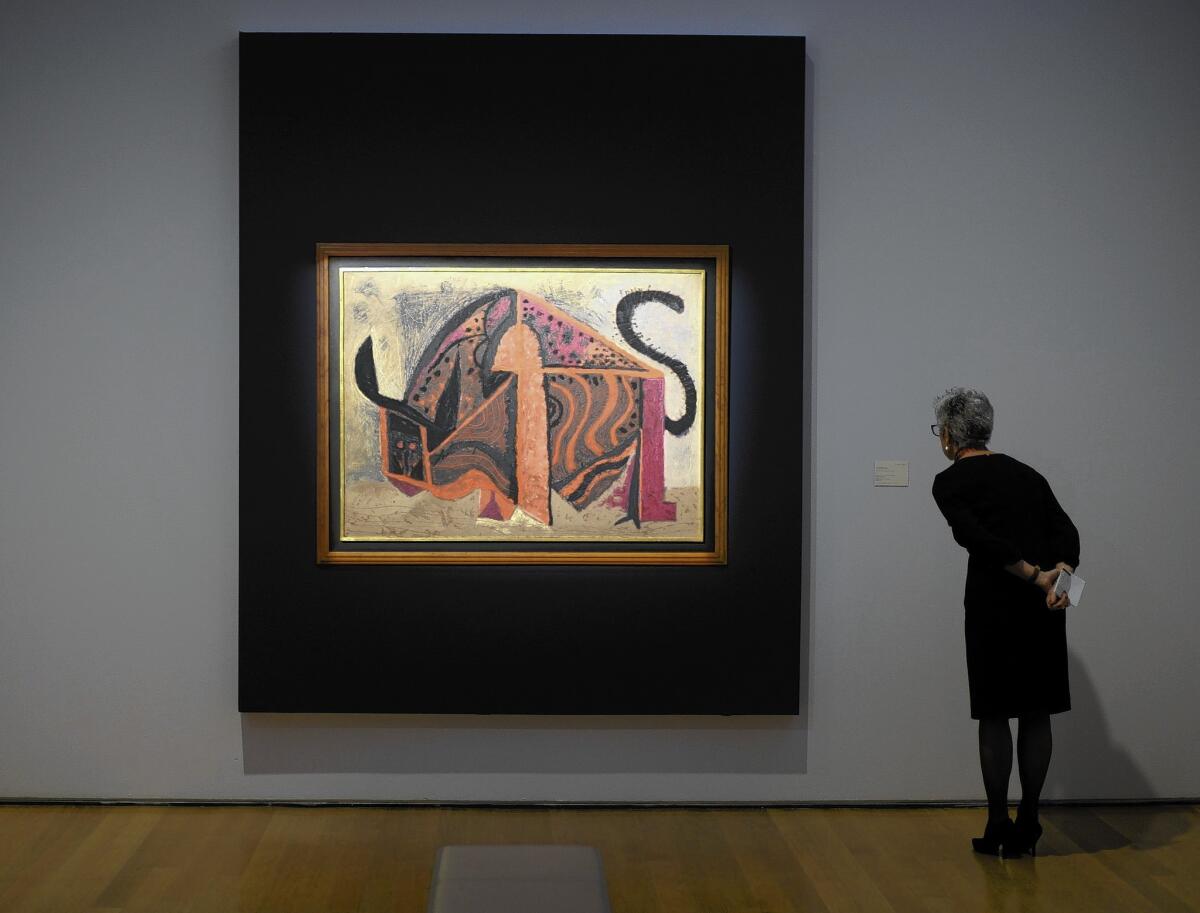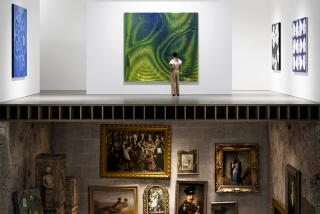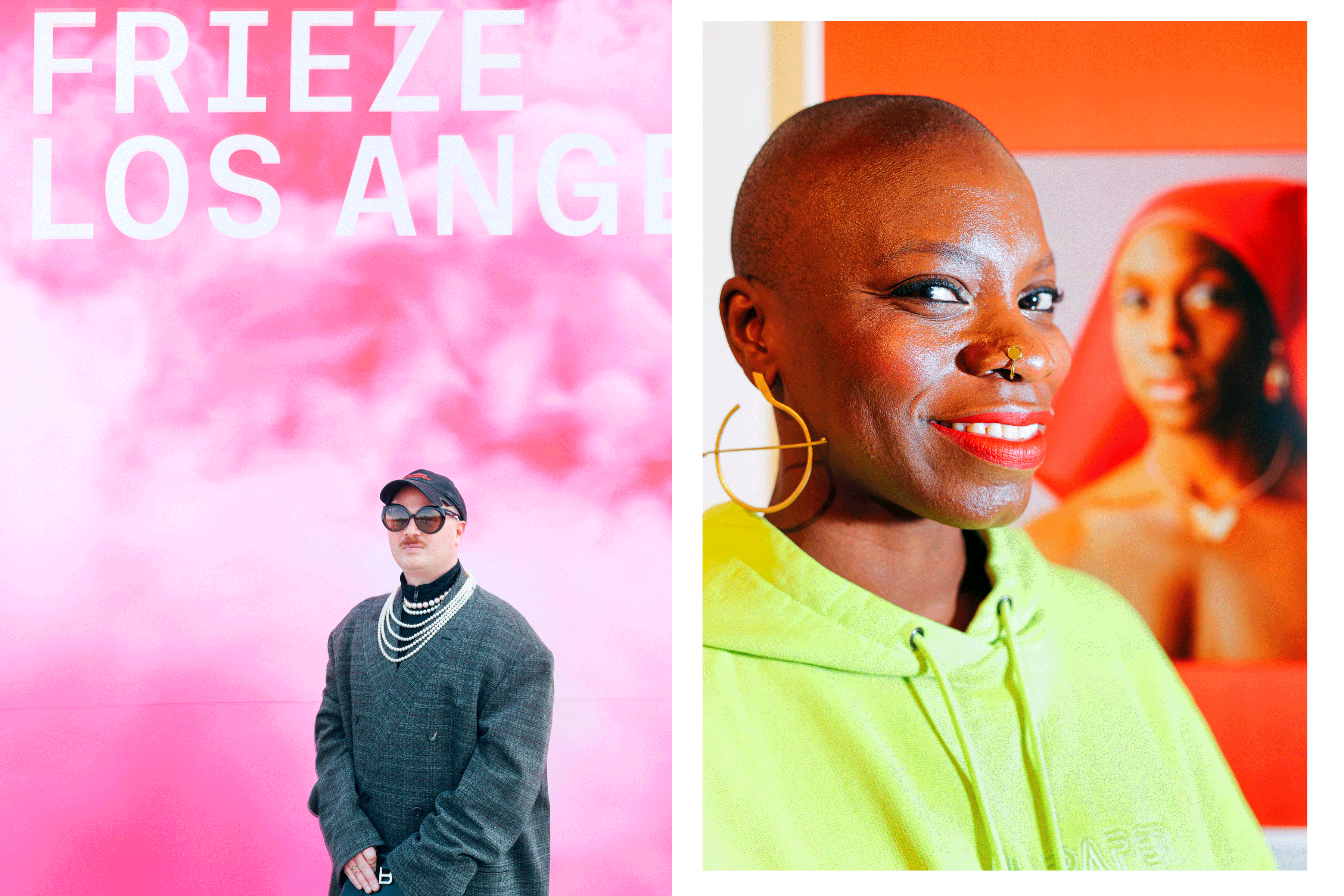New wealth taking art market to new heights

- Share via
NEW YORK — The painting once hung in the Cleveland Museum of Art. And there was no shortage of people who wanted it in the crowded Christie’s auction room.
The artwork, “Women Reaching for the Moon,” is a blur of a woman in a red dress. It was painted by
Rufino Tamayo, the famed Mexican creator of abstract works that combine European and Latino influ-
ences. Though bidding started at $500,000, it quickly reached $1 million. The standing-room-only crowd murmured as auctioneer Adrian Meyer parried with the remaining bidders, and workers wheeled in rows of extra chairs.
“Look at the painting, at least face it. You still have a chance,” Meyer said to a woman in the audience who had been bidding, as the price went up to $1.2 million. “For $50,000, it could be yours.”
When Meyer finally knocked his hammer against the lectern, signaling that the painting had sold for $1.2 million, “Women Reaching for the Moon” became the most expensive work to pass through Christie’s for the evening. The auction, held two weeks ago, was part of Christie’s biannual sale of Latin American art.
But it was not the most expensive to be sold at the auction house this season.
In October, Christie’s sold a triptych by renowned British figurative painter Francis Bacon for $142.4 million, a record price for a painting at auction. The auction house also set a record for the most expensive work by a living artist when it sold a steel sculpture, “Balloon Dog” by American contemporary artist Jeff Koons, for $58.4 million.
Economists may still be worried about consumer spending as the holiday season approaches, but if the art market is any indication, the world’s wealthiest have lots of money to spend.
As small groups of people get richer in various countries across the world, observers say, they’re putting money into art both to gain status and invest in something new. Many have never put their money into art before.
“What we’re seeing is that wealth is expanding in Latin America and the Middle East,” said Phillip Hoffman, head of the Fine Art Fund Group, which consults with wealthy clients who want to buy art. “The new rich like to enjoy art, show it off, have it as an alternative asset.”
Hoffman’s company is 30 times bigger than it was three years ago, he said, as more wealthy clients become interested in owning art. He has 120 clients — most from Asia, Europe and Latin America — who have never owned art before. In fact, one of them dropped $67 million on two paintings.
About 3% of the world’s wealthy now own art, but Hoffman estimates that figure will grow to 30% to 40% in the next decade.
Art as an investment really didn’t come into vogue until the British Rail Pension Fund, which had begun acquiring art in the 1970s, began to divest of its artworks, said Barbara Guggenheim, of the art consultancy Guggenheim Asher Associates. The sales, which mostly occurred in the 1980s and 1990s, netted tens of millions of dollars for the fund, leading to an 11% return.
“For the very first time, Wall Street had something very concrete to look at as a model,” she said. “And Wall Street loves graphs.”
The global art market is now worth about $60 billion.
These days, though, it’s not just art. Wary of losing wealth in the shaky stock market, the super wealthy are also putting money into alternative investments, such as classic cars, wine, gems and watches. Sotheby’s sold a giant flawless pink diamond for $83 million in Geneva last month, the highest ever paid for a gemstone at auction.
But as sales of other luxuries including high-end condos boom, art can go hand in hand, said Martin Friedrichs, assistant director of the Hollis Taggart galleries on New York’s Upper East Side.
“There’s a boom of high-end condos here, and people need something to put on their walls,” he said. “It’s much nicer to hang a piece of art than a printout from your online brokerage account.”
These kinds of high-end investments have been surging as the number of millionaires around the world has increased dramatically in recent years.
According to Wealth Insight, a British firm that tracks global wealth, the number of millionaires in China grew 90% between 2007 and 2012. The number of billionaires in that country grew 400% from 2008 to 2012. And the number of high-net-worth individuals in the Asia-Pacific region grew 29% between 2007 and 2011.
Chinese buyers bid heavily for modern art: Picassos, for example. But Hoffman said they’ve also begun to invest in Chinese antiquities.
Growing wealth among the rich in Mexico has led to more competition for Mexican and other Latin American art, as collectors with more money begin to buy works by artists from multiple countries.
In Mexico, the number of millionaires grew 32% between 2007 and 2012, according to WealthInsight. There were 145,000 millionaires in that country by the end of 2012, holding $736 billion.
“We’ve seen in the past five to seven years clients who did not exist before who are buying quite heavily,” said Gabriela Lobo, director of Christie’s Mexico.
That’s driven up the price of some Latin American artists who barely sold at all a decade ago. At the Latin American art auction, a painting by Austrian-Mexican artist Wolfgang Paalen sold for $200,000; pre-auction estimates had valued the painting at $40,000 to $60,000.
“Some of these things, we couldn’t give them away, or we’d sell them for nothing,” Lobo said. “Now there’s a bigger market for these names.”
Diego Uribe flew to New York from Miami for the Christie’s auction with his wife and bid on a work by Carlos Cruz-Diez. They were outbid. Two out of three of the works for sale by the Venezuelan artist sold for tens of thousands more than Christie’s top estimates.
“You have to have a budget,” Uribe said.
Still, he wishes he’d been able to walk away with something.
“It will get more valuable,” he said.
It’s still not clear whether art is actually a smart investment, especially since the market is considered opaque because many deals are done in private. This puts even more value on the public auctions to gauge how art might be appreciating or depreciating.
“There are periods where art outperforms equities and periods where it underperforms, but the important thing is that it has a low correlation with equities,” he said.
From 1987 to 2012, the Mei Moses World All Art index showed an average annual return of 5%, while the Standard & Poor’s 500 index added 9.6%. Over 60 years, the art index showed average annual returns of 9.5%, while the S&P was up 10.3%.
But for many super rich with extra money on hand, it doesn’t matter whether the artwork becomes more valuable or less. They like to look at it on their walls, regardless of what it costs.
“We don’t buy to sell, but we know it is going to be an asset,” Uribe said. “But if it loses value, I don’t care.”
More to Read
Inside the business of entertainment
The Wide Shot brings you news, analysis and insights on everything from streaming wars to production — and what it all means for the future.
You may occasionally receive promotional content from the Los Angeles Times.











